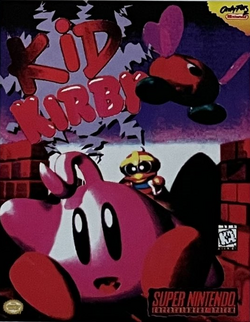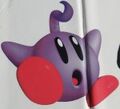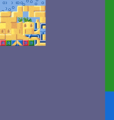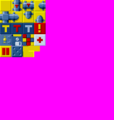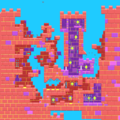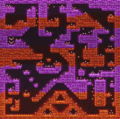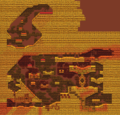Kid Kirby: Difference between revisions
m (Hold on...) |
(→Gameplay: Rewritten the entire section) |
||
| Line 13: | Line 13: | ||
== Gameplay == | == Gameplay == | ||
As the game lacks footage of any sort, there was little-to-no demonstration of the gameplay of ''Kid Kirby''. However, it is described that players would control a hand-shaped cursor using the SNES Mouse, mainly to click, drag, and release Kirby to launch him in a set trajectory. Kirby's launch path would also be determined with guide lines, similar to those used in ''[[Kirby's Dream Course]]''. Additional controls would have included slapping Kirby upwards three times and slamming him downwards when he was in midair. Kirby would've been also able to activate "powerups", which morph him into different forms like a paper airplane or a rock.<ref name="James Watson on GiantBomb"/> | |||
120 | 120 stages were set to be featured in the game, including 60 stages that were part of the game's Story Mode, and the other 60 being secret stages which could be accessed by a hidden door (possibly inside a bell) in the regular stages. In these stages, Kirby could collect [[Point Star|star]]s while reaching the hoop at the end which marked the stage's goal.<ref name="James Watson on GiantBomb"/> "Mike Dailly" also revealed that the stages were set to feature assorted themes like a forest, cavern, laboratory, and even a castle.<ref name="Dailly Assets Reveal"/> | ||
''Kid Kirby'' would have also featured a 2-player split-screen race mode where two players would compete to see who could reach the exit of the level first.<ref name="James Watson on GiantBomb"/> | ''Kid Kirby'' would have also featured a 2-player split-screen race mode where two players would compete to see who could reach the exit of the level first.<ref name="James Watson on GiantBomb"/> | ||
Revision as of 16:55, 24 March 2023
| ||||||||||
|
| ||||||||||
Kid Kirby was a Kirby series game that was once planned to be released on the Super Nintendo Entertainment System. The game would have supported the SNES Mouse, and featured its own colorful unique 3D art style in addition to 2D graphics. Kid Kirby was developed by Scotland-based DMA Design Ltd., which eventually became Rockstar North, a third-party developer known for their work on the Grand Theft Auto series of games.
Overview
The earliest mention ever of Kid Kirby dates back to 1994-1995, where it was said to be in development around the time Lemmings 3 was developed. It was said by ex-DMA Design developer "Mike Dailly" that Nintendo was very fed up with the game and canceled it.[1] The poor sales of the Super NES Mouse and the fact that the game could never be played well with traditional joypad controls were some of the reasons that led to the game's inevitable cancelation.[2] The game was covered by Club Nintendo Mexico in the July 1995 issue, which also included promotional artwork for the game including its box art.[3] Ex-DMA "Mike Dailly" claimed to have a copy of a playable demo build of Kid Kirby, but it was unfortunately lost.[1]
The storyline of Kid Kirby, as told from the perspective of an older Kirby, stars a younger version of himself, who is featured in a more-purple hue with one strand of curly hair. The story would have played out similar to Kirby's Adventure, where the Star Rod is stolen once again from the Fountain of Dreams and Kirby has to go and retrieve it.[4] Familiar characters such as King Dedede (now named "Prince Dedede", as he was not quite a king just yet) and Bronto Burt were set to appear in the game. Additionally, some of the apparent new enemies of the game were a walking fire-like enemy and an unknown octopus-inspired creature. A photo album theme for the menu interface was used for the game, to be more in-line with the fact that it was about Kirby's past memories.[5]
Gameplay
As the game lacks footage of any sort, there was little-to-no demonstration of the gameplay of Kid Kirby. However, it is described that players would control a hand-shaped cursor using the SNES Mouse, mainly to click, drag, and release Kirby to launch him in a set trajectory. Kirby's launch path would also be determined with guide lines, similar to those used in Kirby's Dream Course. Additional controls would have included slapping Kirby upwards three times and slamming him downwards when he was in midair. Kirby would've been also able to activate "powerups", which morph him into different forms like a paper airplane or a rock.[4]
120 stages were set to be featured in the game, including 60 stages that were part of the game's Story Mode, and the other 60 being secret stages which could be accessed by a hidden door (possibly inside a bell) in the regular stages. In these stages, Kirby could collect stars while reaching the hoop at the end which marked the stage's goal.[4] "Mike Dailly" also revealed that the stages were set to feature assorted themes like a forest, cavern, laboratory, and even a castle.[6]
Kid Kirby would have also featured a 2-player split-screen race mode where two players would compete to see who could reach the exit of the level first.[4]
Trivia
- Interestingly, there was a hoax spread online that Hard Hat from Donkey Kong Land was meant to appear in Kid Kirby, as its CG-styled artwork appears alongside other similar-looking promotional artwork of various characters from the latter game on a website covering canceled/beta video games named Unseen64.
- Both artworks for Bronto Burt and Hard Hat appeared in a 2012 auction for an official Nintendo-themed binder that dates back to 1995, which adds up to the confusion.
- This particular piece of Hard Hat artwork appears in higher quality in the preview page for Donkey Kong Land from Volume 69 of Nintendo Power, confirming that the artwork belongs to said game itself and not Kid Kirby.
- According to ex-DMA "Mike Dailly", Kid Kirby's internal name was "Jelly".[6]
- Had it been released as intended, Kid Kirby would become the first Kirby game to be developed by a non-Japanese video game development company.
- A possible method of 100% completion was to get everything on each level to add 1% to the completion counter. There were 120 levels in the game, which would mean 120% completion would be possible.[4]
Gallery
Official artwork
Artwork of young Kirby
Artwork of Prince Dedede
Artwork of Bronto Burt
Sprite sheets
KIRBY2 - Sprite sheet depicting young Kirby's sprites, an unknown fire enemy, potion flasks, and other objects
Stages
DRMBOSS - A boss battle arena located near the Fountain of Dreams.
External links
- "Mike Dailly"'s assets reveal on Flickr (archived)
- Kid Kirby on Unseen64
- Kid Kirby on Kirbytraum (German fansite)
- Intro storyline concept for Kid Kirby (PDF), shared by Steve Hammond
References
- ↑ 1.0 1.1 Twitter PM with "Mike Dailly" (@mdf200) by WiKirby editor Meeper12346, on Imgur (1) (2)
- ↑ "Playing Catch Up: GTA/Lemmings' Dave Jones" on Gamasutra
- ↑ Archived Club Nintendo Mexico July 1995 scan from Destructoid
- ↑ 4.0 4.1 4.2 4.3 4.4 Article from GiantBomb on Kid Kirby by main programmer James Watson, under the name "DudleySoft"
- ↑ Archived page from James Watson (DudleySoft)'s blog
- ↑ 6.0 6.1 "Mike Dailly"'s assets reveal on Flickr (archived)
